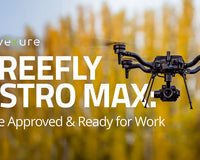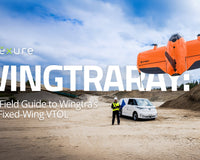What is Remote ID (RID)?
The widespread adoption of drones has changed the aviation landscape in recent years. With so many drones integrated into the National Airspace System (NAS), the Federal Aviation Administration (FAA) has deemed it necessary to develop a way to monitor drone flights at scale. Enter Remote ID (RID).
Remote ID, at its core, acts as a "digital license plate" for drones. It enables drones to broadcast important details such as location, altitude, velocity and the aircraft's serial number (no personal information is broadcasted).
This information can then be accessed by other pilots, authorities, and the general public. The introduction of Remote ID stems from a pressing need to amplify the safety, security, and accountability associated with drone operations, especially when drones operate near other aircraft or sensitive locations.
With the burgeoning use of drones for illegal activities, such as smuggling or spying, Remote ID can significantly mitigate the risks associated with unauthorized drone use.
A Brief History of Remote ID
Remote ID, as a system, has been in development for a few years, but as a drone pilot or end user, the important dates to remember are September 16, 2023, and March 16, 2024. With very few exceptions, which we'll get into later, all drones must be Remote ID compliant (last updated 09/13/2023)
Do I Need to Comply with Remote ID?
So naturally, this begs the question, when and where do you need to be remote ID compliant? Are there exceptions to the rule? Let’s talk about those.

Recreational Drones Under 250g
FAA-Recognized Identification Area (FRIA)

Military Drones
- Drones operated by the US military are exempt from Remote ID
Public Safety SecOps
- Public safety entities needing security-sensitive operations can operate (in limited scenarios) without Remote ID; however, they’ll need to provide justification to the FAA. More on this later.
How to be Remote ID Compliant
If the exceptions above don’t apply to you, you'll need to take the necessary steps to ensure your aircraft is compliant. We understand there has been a lot of confusion and misinformation surrounding Remote ID among our customers and end-users, so we hope this next section will clear things up.
In general, your aircraft will fall into three camps:

Standard Remote ID Drones

Standard Remote ID Drones (with a firmware update)
- These drones are not currently Remote ID compliant but can become Standard Remote ID compliant with a firmware update through the manufacturer (with no hardware modifications or external modules required). If you’re unsure whether your aircraft is up-to-date or falls in this category, we recommend reaching out to the manufacturer.

Broadcast Module Remote ID Drones
List of Standard Remote ID Aircraft
Below is a list of popular aircraft with standard Remote ID built-in that do not require a separate Remote ID module.

To see a more comprehensive list, consult the FAA’s Declaration of Compliance list
List of Recommended Broadcast Remote ID Modules
Advexure actively carries Dronetag Remote ID Modules, however, here is a look at the leading Remote ID modules available in the US market:

Registering Your Drone for Remote ID
Once you’ve determined what type of Remote ID drone you have, you’ll now need to register your drone with the FAA.
Pre-registration Checklist:
Before starting the registration process:
- - Ensure your device holds an FAA-approved Remote ID Declaration of Compliance (this includes both drones and broadcast modules).
- - Keep your Remote ID serial number accessible. If you have difficulty locating it, we recommend reaching out to the drone's manufacturer for guidance.
- - If you previously registered a drone without opting for Remote ID, you'll need to create a new listing for that drone now.
For Recreational Flyers:
- Access the FAADroneZone: Go to the FAADroneZone website.
- Dashboard Navigation: Click the button labeled Launch Drone Owners and Pilots Dashboard. Ensure you're on the Recreational Flyer Dashboard.
- Device Management:
- Click on Manage Device Inventory.
- Choose Add Device.
- Respond Yes to the Remote ID question.
- Select the device type from the given options (either Remote ID broadcast module or Standard Remote ID drone). If you're using a single broadcast module for multiple non-Standard Remote ID drones, opt for the broadcast module for each and specify the drone(s) make/model, using the same Remote ID serial number from the module for the next step.
- Input the Remote ID serial number. This can usually be found either on the drone or its controller.
- Confirm by clicking on Add Device.
- Managing Old Listings: If you wish to cancel a previously registered non-Standard Remote ID drone:
- Within your inventory, locate the drone you'd like to cancel.
- Click on the three vertical dots under the Actions column adjacent to the drone.
- Select Cancel. A canceled device will still appear in your inventory, but its status will reflect as canceled.
For Part 107 Pilots (Editing an Existing Registration):
- Access the FAADroneZone: Navigate to the FAADroneZone website.
- Dashboard Navigation: Click the “Launch Drone Owners and Pilots Dashboard” button. Ensure you're on the Part 107 Dashboard.
- Device Editing:
- Choose Manage Device Inventory.
- Next to the drone, click on the three vertical dots in the Actions column.
- Select Edit.
- Update the Remote ID question's response to Yes.
- Provide the Remote ID serial number. This might be on the drone itself or its controller.
- Confirm changes by clicking on Save.
For Part 107 Pilots (Registering a New Device):
- Access the FAADroneZone: Log into the FAADroneZone.
- Dashboard Navigation: Press Launch Drone Owners and Pilots Dashboard and navigate to the Part 107 Dashboard.
- New Device Registration:
- Select Manage Device Inventory.
- Click Add Device.
- Answer Yes to the Remote ID question.
- From the options, pick the device type (either Remote ID broadcast module or Standard Remote ID drone). If you're employing a broadcast module, denote the drone's make/model when adding the module's Remote ID serial number in the subsequent step.
- Enter the Remote ID serial number, which can be located either on the device or the controller.
- Click Add Device and proceed with the remaining registration steps.
Additional Tips
- - In many instances, the Remote ID serial number and the drone's serial number will be different. Refer to your manufacturer's user guide or website for more information.
- - The first five digits of the remote ID serial number will include 1581E or 1581F.
- - The Remote ID serial number may also appear in the available WLAN Networks in your flight app prefixed by RID, followed by a 20-digit alphanumeric number.. e.g., RID-1581FHDY82100012632
- -We also recommend sticking a 'Remote ID Compliant' sticker onto your drone.
Remote ID Exemptions for Public Safety Entities
The FAA has set forth specific guidance for public safety entities involved in security operations. Let’s break down the details:
Remote ID Compliance Guidelines:
- As of September 16, 2023, all drones that are registered or require registration must broadcast Remote ID.
- For Beyond Visual Line of Sight (BVLOS) operations, drones need to be equipped with standard Remote ID.
- BVLOS operations cannot use broadcast modules unless authorized by the FAA’s Systems Operations Support Center (SOSC) in emergency scenarios.
Handling Delays in Compliance Equipment
If you've ordered Broadcast modules for drones in your existing fleet which lack Remote ID equipment and they won't be available by the compliance date, take the following steps:
- Draft an email on your department's official letterhead to FAA Flight Standards at RIDAuthorizations@faa.gov.
- Describe your situation and request permission to operate the drone without Remote ID until your broadcast modules arrive.
Security Sensitive Operations
For those anticipating operations that require operation without broadcasting Remote ID for security reasons:
- Submit a justification letter, again on department letterhead, to 9-ATOR-HQ-IFOS@faa.gov.
- Until your request has been reviewed and approved, you are mandated to broadcast Remote ID.
- Flights not falling under the definition of a security-sensitive flight must broadcast Remote ID.
For temporary requirements not to broadcast Remote ID in security-sensitive operations:
- - The SOSC is authorized to approve flights without broadcasting Remote ID.
- - Note that this is only applicable in emergency cases for a limited period.
- - In addition, for emergencies, the SOSC can authorize BVLOS flights equipped with a broadcast module for Remote ID.
For any queries related to Remote ID, direct them to the UAS Support Center at UAShelp@faa.gov.
Scenarios Approving Non-Broadcasting of Remote ID
The FAA has listed some potential scenarios where requests to avoid broadcasting Remote ID might be granted. They include:
- - Support operations for Federal agencies, which encompass homeland security, border protection, counter-drug operations, and public resource protection.
- - Covert air operations supporting covert ground-based law enforcement operations. Malicious actors discovering these could harm security personnel, law enforcement, civilians, or property. Examples include covert surveillance of illicit activities such as gang investigations, weapons trafficking, human trafficking, illicit use of public lands, poaching, counterdrug operations, tactical operations, and operations to track and apprehend fugitives.
Important Note:
There is no exemption to the Remote ID rule allowing standard Remote ID drones to turn off Remote ID at this time. Drones updated to broadcast standard Remote ID or those manufactured post-September 16th, 2022, cannot legally deactivate Remote ID broadcasting.
In Conclusion
As we wrap up this guide on Remote ID, we hope you've gained some valuable insights. While the upcoming deadline can feel daunting, remember knowledge is power. We strongly encourage all our pilots and end-users to dig in, research, and make sure you’re prepared for the deadline.
While Advexure isn’t set up for 1-on-1 consultations for Remote ID compliance, we're here to support you in integrating drones into your commercial or enterprise operations.
With a team of Part 107 certified pilots, seasoned drone aficionados, and UAS subject matter experts, we're here to guide, assist, and share our expertise. Stay compliant. Fly Safe!
Sources:
- drone-remote-id.com
- Federal Aviation Administration (FAA)
- https://uavcoach.com/remote-id/
- https://www.droneresponders.org/










